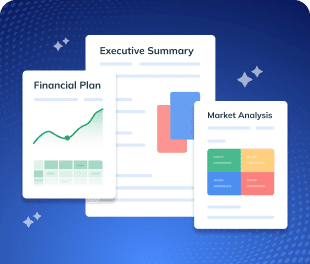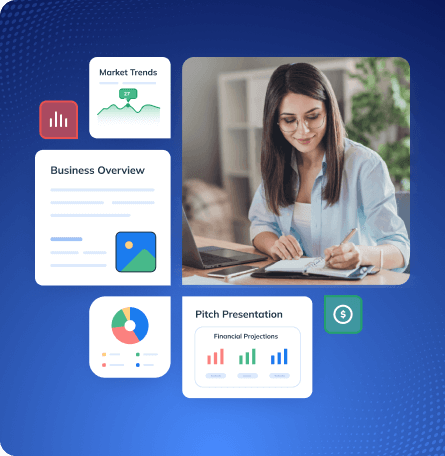Starting a catering business is an exciting venture for anyone who loves cooking and event planning.
But along with delicious recipes and creative menus, you need a solid business plan to turn your culinary dream into a successful catering service.
Need help writing a plan in order?
Don’t worry! This catering business plan template will walk you through everything you need to create a comprehensive plan, step by step, in a friendly and simple way.
What is a catering business plan?
A catering business plan is a professionally written document that outlines the key aspects of your catering business and how it will operate.
Essentially, it’s a roadmap for your catering venture. It describes your business goals, services, target market, how you plan to market your services, as well as financial projections.
Why do you need a business plan for catering services?
Writing a business plan might feel like extra work, especially when you’re eager to start cooking for clients. However, a business plan is crucial for guiding your business and increasing its chances of success.
Here’s why a catering business plan is important:
Give clear direction
It forces you to research and plan how you’ll run the business, preventing costly mistakes. With a plan, you can coordinate cooking, staff, scheduling, and finances without chaos.
Help secure funding
If you need a loan or investors to buy kitchen equipment or a food truck, a well-written plan shows them your business is viable. It highlights what sets you apart from competitors and how you’ll turn a profit, which builds confidence with lenders.
Identify strengths and weaknesses
The planning process helps you spot what you do well and what you need to work on. You can then strategize to leverage strengths and improve weaknesses.
Guide your marketing approach and operations
Your plan outlines who your customers are and how to reach them, as well as how you’ll fulfill orders efficiently. This makes day-to-day management much less stressful because you have a reference for making decisions.
Adapt as you grow
A business plan isn’t static. It’s a living document you can update as your catering business expands or market trends change. Having it written down makes it easier to adjust your strategy when needed.
In short, a catering business plan helps transform your passion for food into a profitable business by keeping you organized and focused.
How to write a successful catering business plan?
Writing a successful catering business plan is like following a recipe: you need the right ingredients (sections) and steps in the right order.
Let’s dive into each section of your catering business plan and what to include.
1. Executive Summary
The executive summary is an introduction to your catering business plan. It’s a concise overview of your entire plan, usually one to two pages at most. Even though it comes first, many people write it last, after they’ve detailed everything else.
In the executive summary, you want to give the reader a clear snapshot of your catering business and its strategy at a glance.
A good executive summary for a catering business should answer the key questions: Who are you, what do you do, and why will you be successful? It typically includes:
- A brief description of your catering company (name, location, what type of catering you specialize in) and your mission statement.
- Who are your customers, and what need are you fulfilling? You might note a gap in the market you’re addressing.
- A sentence on what sets you apart. Do you have a unique menu, special dietary options, a famous chef, or superior customer service?
- A quick look at your expected financial performance or funding needs. For instance, mention your revenue projections or how much capital you’re seeking.
Keep the tone positive and confident. The executive summary should entice the reader to continue reading the rest of your plan. Even though it’s short, make sure it touches on the most important aspects of your business plan in a nutshell.
Say goodbye to boring templates
Build your business plan faster and easier with AI
Plans starting from $14/month

2. Business Overview
The business overview section provides key information about your catering business itself.
Think of it as an “about us” section that gives readers insight into your company’s identity and structure. In this section, you’ll cover who you are, what you do, and how your business is set up.
Here’s what to include in your business overview:
- Company overview: State your business name, location, and legal structure. Are you a sole proprietorship, partnership, LLC, or other entity?
- Founding history and stage: Explain when and how the business started. You might include a brief history of your inspiration for starting the catering service.
- Mission and vision: If you didn’t already mention it in the executive summary, you can include a mission statement here and a vision statement. The mission is your company’s purpose, and the vision is what you aspire to achieve in the long run.
- Core values or USP: It can be good to highlight your core values or unique selling proposition here. Perhaps you emphasize sustainability, or maybe you focus on gourmet presentation. Any unique angle that defines your business philosophy can be noted.
- Current status and goals: Briefly mention where the business stands now (startup phase, already serving clients, etc.) and your short-term goals.
Remember to keep this section clear and engaging. You want to give a reader a solid understanding of your catering company’s identity.
3. Industry Analysis and Target Customers
When planning a catering business, it’s important to show you understand the catering industry and who your customers will be.
Start by describing the current state of the catering industry and any trends, like the rise in corporate lunch services, increased demand for healthy or specialty diets, or growth in private events post-pandemic.
Next, identify who your ideal clients are. You can break this down into segments:
- Private clients like couples getting married, families throwing birthday parties, or reunions. These customers often look for memorable menus and full-service catering (food plus service staff).
- Business clients who need catering for meetings, conferences, training, or office parties. They value reliability, timely delivery, and a professional presentation.
For each segment, briefly mention what they need and how your service fits. Understanding your market in this way helps readers see that there is demand for your catering business and that you have customized your services to meet the needs of those specific customers.
To make this even clearer, you can outline a basic customer persona. These simple profiles show who your customers are, what they care about, and how your catering service meets those needs.
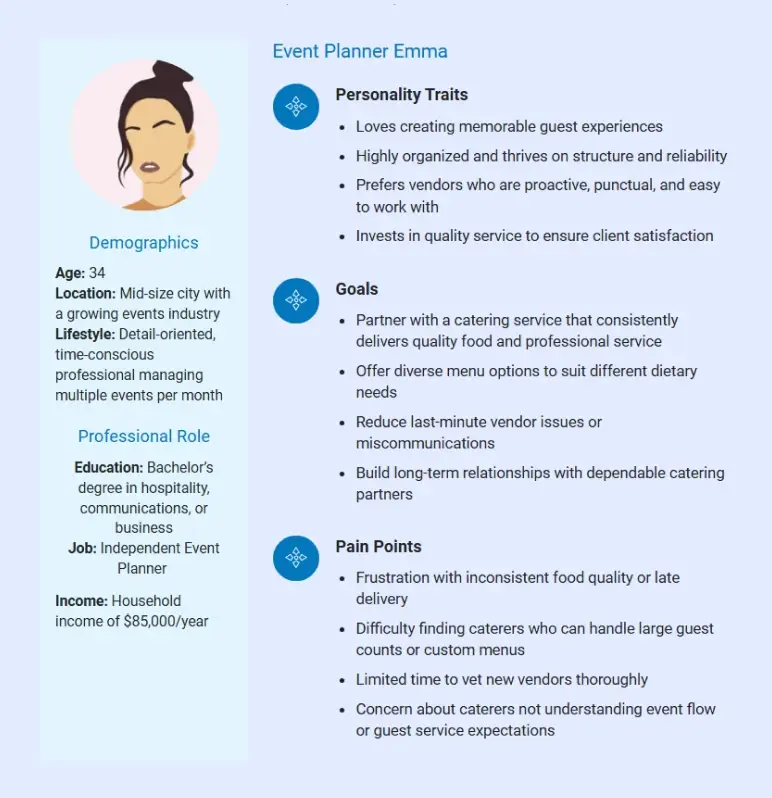
4. Competitor analysis
Every catering business has competition, so it’s important to show that you know who else is out there and what makes your service different.
This part explains how to look into what your competitors are doing, spot what they’re doing well (and not so well), and use that to help your business stand out.
Here’s how to approach it:
- List 3–5 key competitors in your area. Include their name, the type of catering they offer
- Compare their services to yours. Identify whether they offer menu items or packages that you don’t—or if you have offerings they lack.
- Evaluate their pricing strategy. Are they more affordable, more premium, or similar to yours?
- Read through customer reviews to see what clients like or dislike about their service, pay attention to things like food quality, punctuality, or staff professionalism.
- Clearly state your competitive advantage—what makes your catering service the better choice. This might include a unique menu, flexible packages, faster response time, or online ordering.
In addition to that, include a simple SWOT analysis to summarize your position in the competitive marketplace. Outline your internal strengths and weaknesses, as well as external opportunities and threats in the local catering market.
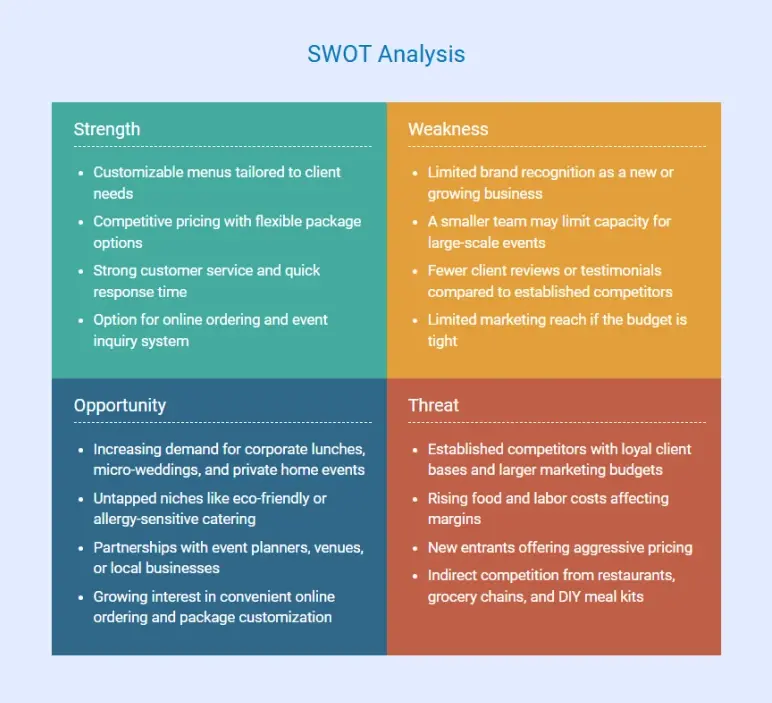
With this competitive analysis, you demonstrate that you understand the market landscape and have a clear strategy to carve out your place in it. This not only builds confidence with investors and partners—it also helps you stay one step ahead.
5. Products and Services
This section of your plan explains what you’ll cater and how you’ll do it. You want to clearly outline the services you offer and any unique features.
Essentially, this is where you describe your menu, the types of events you cater, and the scope of your service—whether it’s just food delivery or full-service with staff.
By covering the points below, you give a complete picture of what clients can expect when they work with you.
| Service Element | Details |
|---|---|
| Types of Events | Weddings, birthday parties, family gatherings, corporate luncheons, business functions, private dinners, and community events |
| Menu Offerings | Diverse menu with options for Italian, BBQ, vegan, and fusion cuisine; can accommodate dietary restrictions and custom menu requests |
| Service Style | Buffet-style drop-off, full-service plated meals, on-site cooking with staff, and optional bartenders; flexible depending on event size and type |
| Additional Services | Dinnerware and table rentals, linens, event setup and cleanup, coordination support—ideal for clients seeking one-stop event services |
| Packages/Customization | Combination of preset packages (e.g., “Party of 50”) and fully customized menus; offer tastings and planning consultations for large events |
| Pricing Model | Charges per person, per platter, or flat event rate depending on menu and setup; minimum guest count (e.g., 20) may apply; typical pricing: $25–$50 per person |
| Quality & Sourcing | Fresh, locally sourced ingredients used; recipes are prepared from scratch on the day of the event for maximum flavor and quality assurance |
By outlining these service details, you make it easy for clients and investors to understand exactly what you offer and how your catering stands out.
Whether it’s a backyard birthday or a corporate gala, ensure your flexible service styles, custom menus, and commitment to quality make your business a trusted choice for any occasion.
6. Marketing Strategy
If you want people to book you, they need to know you exist!
Having great food and service is important, but getting the word out is just as critical. That’s what this part is for—showing how you’ll reach customers and get them to hire you.
You don’t need to overthink it. A few good methods done consistently can go a long way.
Website and SEO
Build a simple website that covers the basics of what you serve, a few photos, reviews, and how to reach you. Think about what people would search for. If someone types “caterer near me” into Google, your name should come up.
Social Media
Post your best food shots on Instagram or Facebook. Don’t be afraid to show some behind-the-scenes prep or happy clients. Talk like yourself. People love booking from businesses that feel real.
Online Reviews and Directories
Encourage happy clients to leave reviews on Google, Yelp, or wedding/event planning sites. Positive reviews build trust and greatly influence new customers.
Also, list your business on relevant online directories or marketplaces for catering services so you’re visible where people are looking.
Traditional Advertising
If you’re looking to reach local customers who aren’t online, traditional marketing can still work. Try placing ads in community newspapers, handing out flyers in busy areas, or joining local events and expos.
These methods help build brand awareness and connect you with a broader audience.
7. Operations Plan
The operations plan explains how your catering business will function on a daily basis. It outlines where and how food will be prepared, what resources you’ll need, how events will be executed, and how you’ll maintain service quality.
This section shows that you have a clear process in place to run your business smoothly and consistently.
The following are the key elements to cover in this section:
- Location and facilities: Describe your kitchen setup—commercial kitchen, commissary, or permitted home kitchen—and mention any required licenses or permits.
- Equipment and supplies: List essential kitchen equipment, catering vehicles, and serving tools. Briefly mention how and where you’ll source ingredients and supplies.
- Food preparation process: Explain your planning timeline, prep schedule, and how you ensure food is fresh and ready on time for each event.
- Staffing and roles: Outline your team structure, including who cooks, who delivers, and who serves. Include both core staff and on-call help for events.
- Day-to-day workflow: Describe how bookings are handled, how orders are scheduled, and what a typical prep and event day looks like.
- Quality control: State how you maintain food safety, manage last-minute issues, and gather client feedback to improve service.
Besides these operational aspects, you should highlight how many events you can currently handle and what steps you’ll take to expand operations as demand grows.
By covering these key areas, you show that your catering business has the systems and support to operate efficiently and grow over time.
8. Management Team
Investors and stakeholders don’t just invest in ideas—they invest in people.
This section introduces the individuals running your catering business and the skills they bring. Whether it’s just you or a small team, the goal is to show you’re capable of executing the plan.
Start with the owner. Provide names, titles, and a brief background. Mention relevant experience, like a culinary degree, years in restaurants, or a co-founder with event or business expertise. Highlight any accomplishments or key strengths.
If you have other team members, include them too. This could be a kitchen manager, event coordinator, or mentor. For each, list their role and a short line about their experience or strengths.
If your team includes more than a couple of people, describe the structure. Who reports to whom? Explain this in writing or with an org chart.
The organizational chart below outlines the team structure, reporting lines, and key responsibilities at a glance.
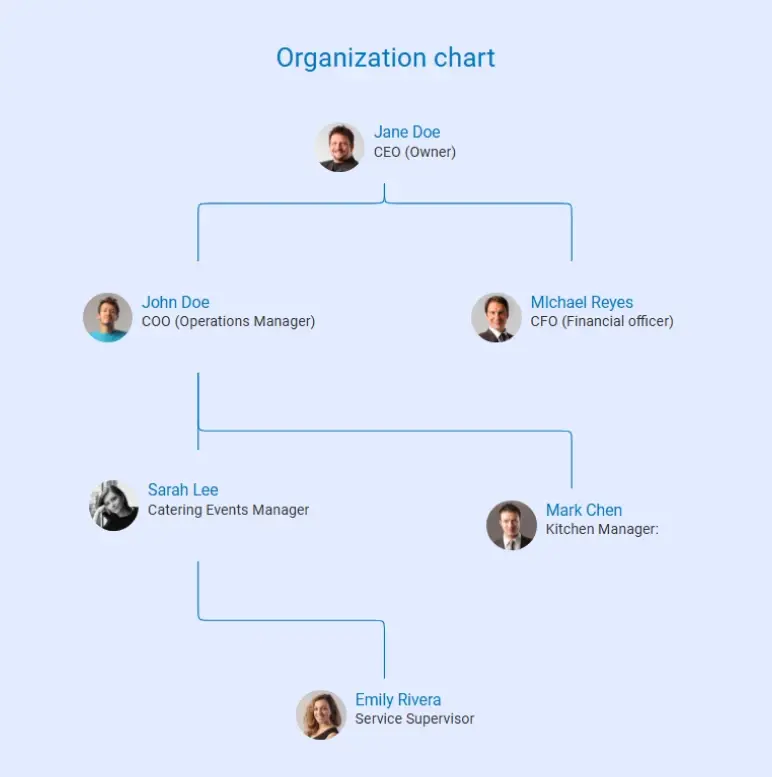
If there are gaps in expertise, acknowledge them and share your plan to fill them. This shows awareness and preparation for future growth.
End this section with confidence. Show that your team can deliver—and that you’re ready to strengthen it as needed.
9. Financial Plan
When I was getting started with my catering venture, one of the trickiest parts was figuring out the money side of things. This section of the financial plan is where you put all of that into perspective.
It’s about being honest about what it will cost to launch, what sort of income you can realistically expect, and where you might need some financial help.
I looked at everything: from the price of kitchen equipment and ingredients to how much I’d need for part-time staff. Writing it down helped me make sense of how the business could grow without stretching too thin.
In your catering financial plan, consider including:
- Startup costs
- Revenue model
- Ongoing expenses
- Funding requirements
- Profitability outlook
- Break-even analysis
Make sure your financial projections are realistic and based on clear reasoning. It’s helpful to explain the assumptions behind your numbers. If you’ve already made sales, include those figures as evidence of demand.
Be ready to support your estimates with supplier quotes, cost breakdowns, or industry benchmarks.
Download a free catering business plan template
Need help writing your own catering business plan from scratch? Don’t worry—we’ve got you covered. Download our free catering business plan PDF to get started.
This professionally designed template is made specifically for caterers and food service entrepreneurs. Use it as a reference while creating your own plan, or customize it to match your event style, target market, and business goals.
The Quickest Way to turn a Business Idea into a Business Plan
Fill-in-the-blanks and automatic financials make it easy.
Conclusion
We’ve walked through all the essential parts of a catering business plan, from your menu and services to operations, marketing, and financial projections. You also have access to a free sample plan to help guide the writing process.
Whether you’re launching a brand-new catering service or refining an existing one, a well-structured plan will give you clarity and direction.
If you’d prefer to skip the formatting and focus on your food, Upmetrics is here to help. It’s an AI-powered tool that makes business planning simple, from financial forecasts to market research.
Try Upmetrics today and turn your catering vision into a thriving business.
